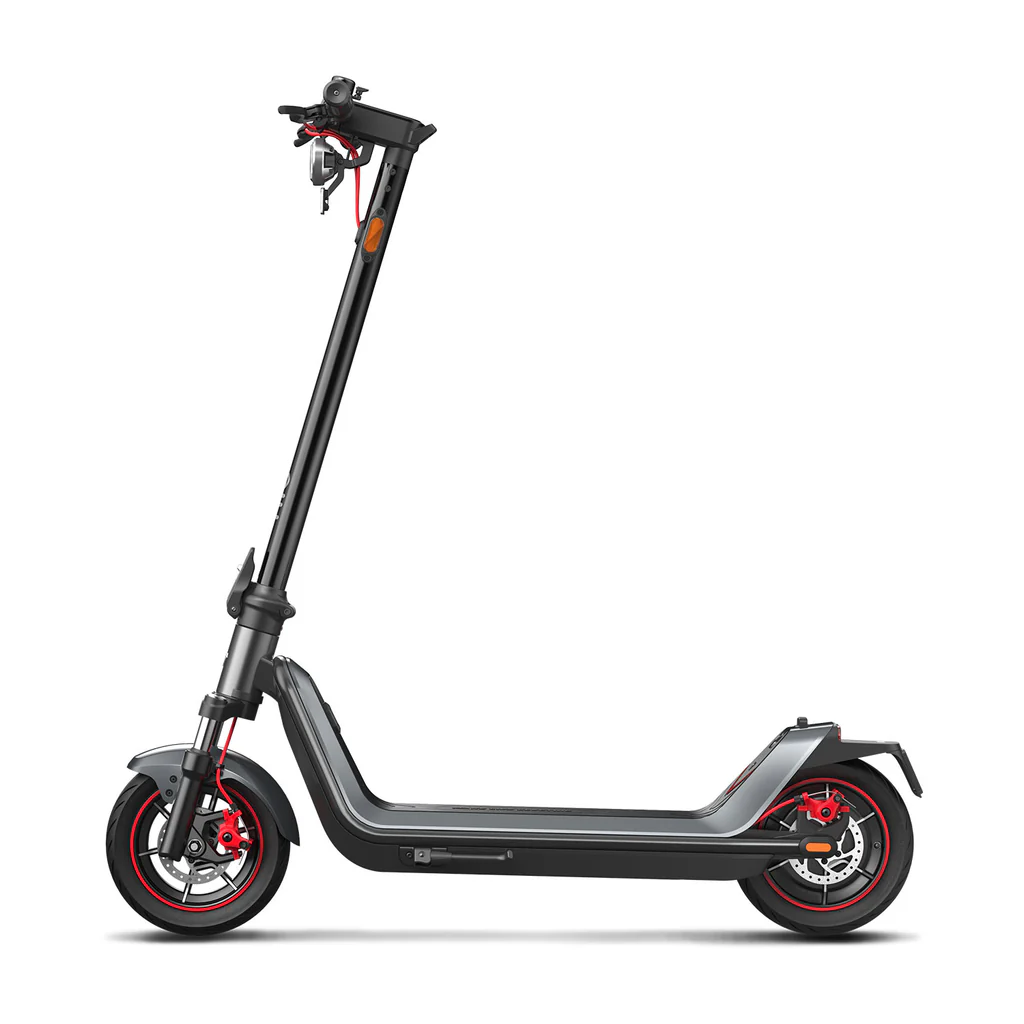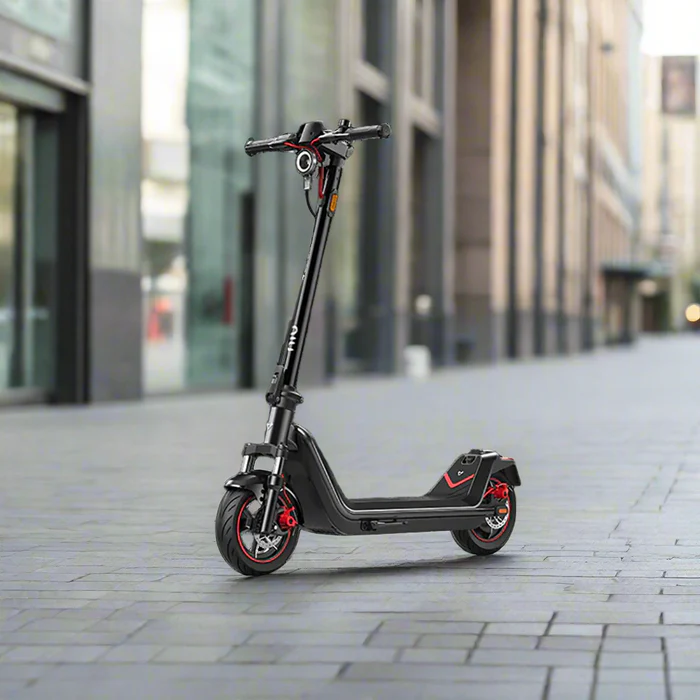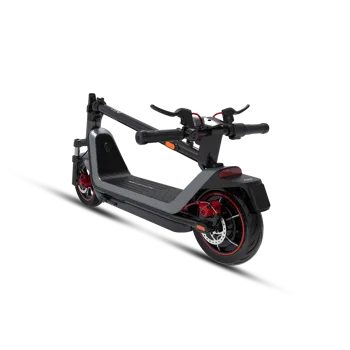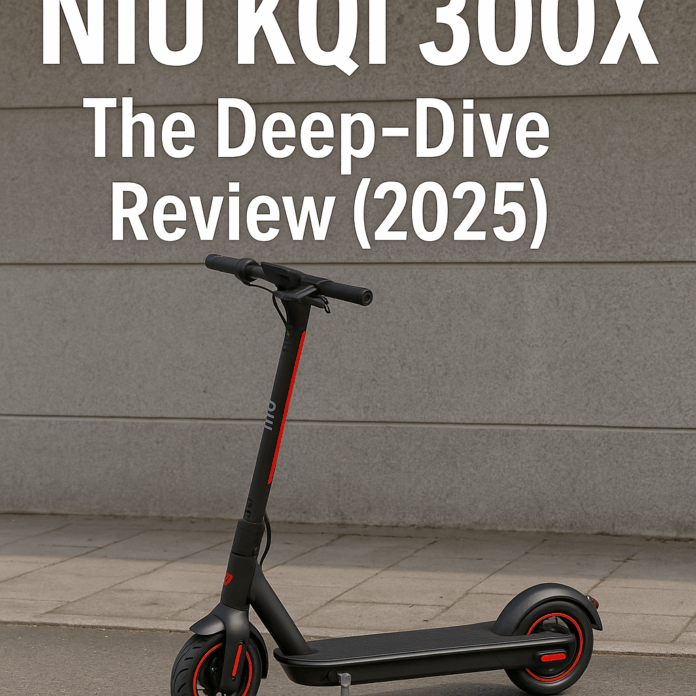NIU KQi 300X – The 3,000-Word Deep-Dive Review (2025)
Comprehensive NIU KQi 300X review: specs, speed, range, comfort, safety, pros/cons, and buying advice for modern commuters.
NIU KQi 300X review, NIU KQi 300X Specifications, NIU KQi 300X speed, NIU KQi 300X range, NIU KQi 300X weight
Introduction
The NIU KQi 300X sits in a sweet spot for riders who want a premium feeling commuter without straying into heavyweight, 30-plus-mph performance territory. The 300X takes the proven NIU KQi platform and dials it up with a higher-voltage battery, serious braking, wide cockpit geometry, and a front hydraulic suspension fork that absorbs the nasty chatter of urban pavement. It also layers on the software: the NIU app handles locking, ride stats, OTA updates, and mode tuning. As a result, the scooter feels like a cohesive product, not a parts-bin mashup.
At a glance, the story is simple: a robust 48 V system paired with a torquey rear hub (nominal mid-power, high peak output), a practical real-world range that satisfies routine commutes, and a speed ceiling that respects public-road limits in many regions while still feeling lively on private property. Add tubeless tires, excellent lighting, and a frame that keeps its composure at speed, and you get a commuter that rewards daily use.
TL;DR: The NIU KQi 300X is a refined, app-connected, and comfort-oriented commuter with a strong 48 V battery, hydraulic front suspension, tubeless tires, and confident brakes. It favors stability, safety, and quality over bragging rights. If your daily rides sit between 5 and 15 miles and you value reliability and polish, this is an easy recommendation.

NIU KQi 300X – Key Specifications
| Battery | 48 V, 13 Ah (≈608 Wh), NIU Energy pack |
|---|---|
| Motor | Rear-hub, rated mid-power with ≈1,000 W peak (region-dependent) |
| Top Speed | Up to 20 mph (on-road in many regions); up to ≈23.6 mph on private property (region/app dependent) |
| Max Range (claimed) | Up to ≈37 miles per charge (conditions vary) |
| Real-world tested range | ~27 miles at mixed speeds (independent testing; varies by rider/route) |
| Suspension | Dual-tube hydraulic front fork |
| Brakes | Mechanical disc (front), regenerative electronic rear, with rear lighting |
| Tires | Tubeless pneumatic, approx. 10.5 × 2.5 in (region variants exist) |
| Hill Grade | Up to approx. 25% (manufacturer claim; rider/load dependent) |
| Weight | ≈48.7 lb (inc. battery) |
| Max Rider Load | Up to ≈265 lb (120 kg) |
| Water Resistance | IP55 class (splash-proof; not submersible) |
| Handlebar Width | ≈21.3 in (wide for leverage) |
| Deck Size | ≈22.4 in length; ≈6.5–7.5 in width (varies by region) |
| Riding Modes | Eco / Sport / Custom / Pedestrian (via app) |
For your in-site interlinking and to guide readers deeper into specs, link to your product page: NIU KQi 300X Specifications.
Design & Build Quality: Clean Lines, Solid Bones
NIU’s industrial design gives the KQi 300X a purposeful look that survives daily scuffs. The stem is stout, the latch is positive, and the cable routing is tidy rather than flamboyant. The deck wears a textured, grippy surface that doesn’t trap grime and provides sure footing in light rain. The body panels resist fingerprints and micro-scratches better than most glossy finishes, so the scooter stays presentable even after months of commuting.
The wide handlebar immediately stands out. Extra width gives more steering leverage and a calmer front end at speed. It also helps when you need to correct mid-corner or skirt a pothole. NIU’s geometry places your shoulders open and neutral, which reduces fatigue on longer rides. The deck is long enough for a comfortable staggered stance; you can place your front foot at 45° and square the rear for braking stability. Because the deck sits low, step-on height is friendly and center of gravity stays planted.
Attention to detail also shows in hardware choices. Fasteners resist corrosion. The kickstand is confidence-inspiring; it holds the 300X without drama on mild slopes. The folding mechanism clicks into place without excessive play, and the locked-down package is compact enough for elevators, lifts, and office corners. You can roll it by the stem to avoid heavy carrying through long corridors. Little touches—such as a well-sealed charge port and a bright headlight—round out a design that feels truly commuter-centric.
In short, the 300X looks mature and rides like a tightly assembled machine. It is not ultra-light; however, it feels like a proper vehicle, and that confidence counts every time traffic closes in or a sudden stop is required.

Performance & Power: Calm Speed, Strong Pull
Performance starts with the 48 V battery architecture and a rear-hub motor tuned for steady torque rather than explosive launches. From a stop, the KQi 300X steps off briskly and builds to commuter speeds without lurching. That behavior suits dense city streets: you don’t wheel-spin on painted lines or lose traction mid-turn. Acceleration to the mid-teens is quick enough to keep pace with bike-lane traffic, while the upper reach to the regulated top speed is smooth and predictable.
Hill behavior is a common concern for mid-power scooters. The 300X handles typical 6–10% city grades with poise. On steeper ramps, speed drops but control remains. Choose a slightly earlier entry speed, keep your weight centered, and hold a firm line. The controller doesn’t surge or cut abruptly; it modulates input cleanly, which is what you want on slick or uneven surfaces. In hot weather, the 48 V system helps resist voltage sag late in the battery, so the scooter keeps a decent feel as the day winds down.
Top-speed limits vary by region because of local regulations. In many markets, the 300X caps around 20 mph for on-road use. On private property, some riders unlock higher ceilings (≈23–24 mph) using app settings. Either way, the chassis feels planted. At max speed on smooth pavement, steering stays neutral and wobble-free. Hands remain steady on the wide bar, and the fork absorbs minor corrugations that might rattle a rigid scooter.
Long story short: the 300X is not built to win drag races. It is built to cover ground quickly, quietly, and safely. On that score, it delivers, especially when matched with tubeless tires and a fork that filters out chatter.
Battery & Range: Where 48 V Meets Reality
A commuter scooter lives or dies by its battery quality. The KQi 300X uses a 48 V, 13 Ah pack with around 608 Wh of energy. That capacity, combined with NIU’s conservative controller tuning, yields a healthy claimed range under gentle riding. Real-world numbers vary with rider mass, rolling resistance, stop frequency, grade, temperature, and average speed. In mixed riding at mid-teens to near-cap speeds, many owners report totals in the mid-20-mile bracket on a single charge. That figure lines up neatly with independent tests that hover around the 27-mile mark in realistic conditions.
To stretch range, ride in Eco mode during long flats and save Sport for merges and short hills. Keep tire pressures on spec; a few PSI low can cost several miles. Cold weather reduces available energy, so store the scooter indoors and begin rides soon after charging when it’s chilly. Avoid deep discharges for longevity; partial top-offs between 30% and 80% are kinder to cells if you don’t need maximum distance that day.
Charging typically takes a school or work shift. Many riders plug in at the office or overnight at home. The charge connector sits high enough to avoid splash exposure, and the port cap seals positively. If you log serious mileage, consider a simple battery log in the NIU app or a spreadsheet to track charge cycles and seasonal range—these small habits reveal patterns that help planning.
In the commuter context, the 300X’s range hits the sweet spot: long enough to banish daily anxiety, short enough to keep weight manageable. Unless you routinely cover more than 15 miles per day at full tilt, you’ll likely charge twice a week rather than nightly.
Ride Comfort & Handling: Quiet, Stable, and Predictable
Comfort is where the 300X separates itself from rigid-fork commuters. The hydraulic front suspension eats high-frequency vibration and softens sharp edges from expansion joints and brickwork. Paired with tubeless pneumatic tires, the system delivers a composed ride that stays stable in crosswinds and on broken pavement. You will still feel bigger hits; this is city suspension, not an off-road damper. Yet the fork takes the sting out of repetitive impacts that fatigue your hands and knees.
Steering manners are excellent. The wide bar disperses inputs, so the scooter doesn’t feel twitchy at speed. The low deck helps balance. The geometry wants you to stand relaxed and keep your head up—ideal for scanning traffic far ahead. In chicanes, the chassis follows lines without drama. With practice, you can draw smooth arcs, roll on throttle at corner exit, and cover ground efficiently.
Another comfort win is silence. The 300X rides without rattles, and the motor note stays muted. On early morning runs, you can hear birdsong and tire hiss rather than gear whine. That quiet confidence is the hallmark of a well-sorted commuter and a big reason riders stick with the platform for years.
Braking, Lighting & Safety: Confidence by Design
A great commuter must stop as well as it goes. The KQi 300X pairs a mechanical front disc with regenerative rear braking. The front lever offers progressive bite; the regen supplements it by slowing the rear wheel smoothly and harvesting a bit of energy. With practice, you can trail the front into a corner entrance, then release smoothly as you stand the scooter up. Emergency stops remain predictable; your weight loads the front tire while the chassis tracks straight.
Lighting matters as much as brakes in city traffic. The 300X’s headlight casts a bright, wide beam and sits high on the stem for visibility. The taillight is bright and responsive during braking. Side reflectors aid cross-traffic visibility near intersections. The package feels “automotive,” not perfunctory, which breeds trust on dark rides. For extra conspicuity, we still recommend a helmet-mounted light and a reflective ankle band; moving reflectors catch drivers’ eyes faster at night.
Safety also includes software. The NIU app can limit top speed for new riders, activate an electronic lock that prevents throttle engagement, and track ride stats that help you analyze risky segments of your route. Firmware updates arrive over the air and can refine throttle feel, improve error handling, or adjust lighting logic. That maintenance-through-software model is rare in the commuter class and gives the 300X a long useful life.
Portability & Daily Use: Heavier Than Ultralights, Lighter Than Speedsters
At just under 50 lb, the 300X weighs more than a featherweight last-mile scooter but less than dual-motor brutes. For most riders, that means short stair carries are fine, while four flights will feel like a workout. The good news: folded dimensions are practical, and the latch stays secure when you roll it by the stem. In commuter life, rolling beats carrying.
Transit compatibility is good. The folded bar fits through bus aisles and station gates. Under-desk storage works in most offices, though we still recommend a scooter mat to catch dust and drips on wet days. In compact car trunks, the 300X fits diagonally; hatchbacks and SUVs swallow it easily. If you park in a bike room, bring a U-lock and a cable to secure the frame and a wheel; electronic locks deter opportunists but won’t stop a determined thief.
Daily ritual is easy. Power on, check the battery on the display or app, choose your mode, and roll. After work, plug in where convenient. The charger brick is compact enough for a laptop bag. Over weeks, you’ll learn your route’s energy rhythm and charge schedule becomes second nature.

Controls & Connectivity: Simple Interface, Powerful App
The cockpit layout is intuitive: throttle on the right, brake lever on the left, center power/mode control, and clear readouts. You can toggle Eco/Sport quickly, and cruise control engages after holding steady throttle for a few seconds (tap the brake to cancel). The display stays legible in bright daylight and dims politely at night.
The NIU app is the secret sauce. Pairing is quick, and the dashboard mirrors real-time speed, battery percentage, and temperature. You can define a custom mode to cap speed for new riders or to save energy on long days. You can also lock the scooter electronically so throttle won’t engage without your phone or code. Importantly, firmware updates land in-app—no cables, no guesswork. Over time, small tweaks accumulate into a noticeably more polished ride.
Maintenance, Reliability & Ownership Experience
The 300X is built to shrug off daily use. Tubeless tires resist pinch flats and allow sealant use; they also roll more efficiently than solid tires. Check pressures weekly. The front disc pad wears slowly in city use and is easy to replace with basic tools. The regen system reduces mechanical brake load at low speeds, which further extends pad life. Keep the fork stanchions clean and inspect the wiper seals occasionally; a dry microfiber wipe after wet rides goes a long way.
On the electrical side, avoid blasting the deck and stem with pressure washers. The scooter carries a solid splash rating, but long soaks or direct jets will find their way into places they don’t belong. After rain, dry the charge port cap and leave the scooter in a ventilated spot before charging. If you ride through winter, consider a fender-flap extension to keep slush off the deck. As with all lithium-based systems, store around half charge for longer breaks and avoid leaving the pack at 0% or 100% for many days.
Parts support is a bright spot. NIU supplies tires, tubes (where applicable), brake components, and deck parts through regional channels and retailers. Community knowledge is robust as well; riders share setup tips, tire alternatives, and pad part numbers. Expect a calm ownership curve: simple upkeep, periodic updates, and few surprises.
Real-World Use: Three Commute Profiles
1) The Cross-Town Sprinter (8–10 miles daily)
Rider A covers about 4–5 miles each way on mostly flat bike lanes with a few short hills. They ride in Sport on the way in to save time, then use Eco on the return to stretch range without a midday charge. Weekly energy pattern: two full charges across five workdays. They value the wide handlebar on gusty days and the fork for brick sections near the riverwalk. After a month, they add a mirror and a bar-end bell. The scooter’s speed ceiling feels just right: quick enough to merge, capped enough to stay legal.
2) The Multimodal Connector (Train + 3 miles)
Rider B walks to a station, folds the scooter, rides 25 minutes by rail, then unfolds for a three-mile city segment. The 300X’s fold-to-roll behavior makes the station stroll painless. The rider sets a custom top speed slightly below maximum for extra range and uses the app lock while grabbing coffee. The scooter slides under a shared desk; a small mat keeps winter drips off carpet. On Fridays, they detour around the park and use more of the fork’s travel over tree-rooted paths.
3) The Hilly Neighborhood Commuter (short but steep)
Rider C faces two 10–12% hills over a short commute. They enter the climb with a bit of speed and maintain a neutral stance as the motor digs in. Speeds drop on the steeper sections but remain manageable. Regen braking saves their hand from the last downhill into a four-way stop. They top off at work and get back home with plenty to spare. After a few weeks, they bump tire pressure slightly for lower rolling resistance and use the fork to cushion sharp edges at the hill crest.
Comparisons: KQi 300X vs. KQi 300P vs. Popular Alternatives
NIU KQi 300X vs. NIU KQi 300P
| Feature | KQi 300P | KQi 300X |
|---|---|---|
| Motor (rated / peak) | ≈450 W / ≈900 W | ≈500 W / ≈1,000 W |
| Battery | 48 V, ≈10.4 Ah | 48 V, ≈13 Ah |
| Max Range (claimed) | ≈30 mi | ≈37 mi |
| Weight | ≈46 lb | ≈48.7 lb |
| Suspension | Dual-tube hydraulic (front) | Dual-tube hydraulic (front) |
| Top Speed (on-road) | ≈20 mph | ≈20 mph |
The 300P is the lighter, slightly shorter-range sibling with a lower rated motor. The 300X leans into battery capacity and peak power. If you climb more hills, carry more weight, or want the longer buffer between charges, the 300X is the natural pick. If you prioritize a couple pounds less and don’t need the extra miles, the 300P saves a bit of cash.
NIU KQi 300X vs. Typical Mid-Class Commuters
- Versus rigid-fork commuters (no suspension): The 300X rides calmer over rough patches thanks to its hydraulic fork. It weighs a bit more but pays you back in comfort and control.
- Versus bigger “sport commuters” (dual motors, 28–35 mph): The 300X is saner in city traffic and easier to carry. It cannot match their acceleration, yet it also doesn’t demand motorcycle-like attention or heavy-duty storage.
- Versus featherweight last-mile boards: The 300X beats them in stability, braking, and confidence at 18–20 mph. If you only ride a mile at 10 mph, you may not need its capability; if you want headroom, you’ll appreciate it daily.
Community Feedback: What Riders Highlight
Owners tend to praise the 300X for its premium feel, reassuring brakes, and calm high-teens-to-20 mph cruising. Many call out the fork as a genuine upgrade over rigid scooters, especially on broken pavement. The app earns kudos for painless pairing and regular updates. Most criticism centers on tire availability in certain markets and the obvious trade-off of weight versus portability. Some riders also note that unlocking higher top speeds should be used judiciously and only where legal.
Buying Advice & Setup Tips
- Unbox smart: Inspect packaging, note any damage, and photograph the scooter before first power-on. Check fasteners, latch play, and cable routing.
- Set pressures: Inflate tires to the recommended PSI for your weight and surface. Re-check after the first 20 miles.
- Bed the brake: Perform repeated smooth stops from moderate speed to seat pads and rotor. You’ll get quieter, stronger braking.
- App essentials: Pair your phone, set a PIN or lock, configure modes, and check for firmware updates. Consider a custom mode for training new riders.
- Security: Use a U-lock and a cable in bike rooms. The app lock is a deterrent, not a replacement for a physical lock.
- Wet-weather habits: Slow down on painted lines, avoid deep puddles, and dry the scooter before charging. Add a helmet light for better visibility.
- Maintenance cadence: Weekly tire checks, monthly fastener and cable checks, and seasonal cleaning keep the scooter tight and quiet.
Pros & Cons
Pros
- Refined, stable ride with hydraulic front suspension
- 48 V battery and strong peak power for hills and heavy riders
- Tubeless pneumatic tires for grip, comfort, and puncture resistance
- Excellent lighting and braking for city safety
- NIU app: OTA updates, lock, custom modes, ride data
- Wide bar & long deck: relaxed ergonomics and confident control
Cons
- Heavier than ultralight last-mile scooters
- Range drops at sustained top speed or in winter (as expected)
- Regional spec variations (tires, deck width) may confuse buyers
- Tire availability can be spotty in some markets
Final Verdict
The NIU KQi 300X nails the commuter brief. It rides quietly, brakes hard, lights the road well, and cushions the ugly bits of city pavement. The 48 V battery and healthy peak power give you day-to-day headroom, while the app extends the scooter’s life through updates and easy diagnostics. You do carry a few more pounds than ultralights, but you gain stability, safety, and comfort where it matters.
If you want a stress-free, modern, and polished scooter for everyday transport—and you care more about reliability and refinement than raw speed—the 300X is one of the smartest picks available today. For readers who want technical specifics and ongoing in-house notes, keep an internal link handy to your specs page: NIU KQi 300X Specifications.



